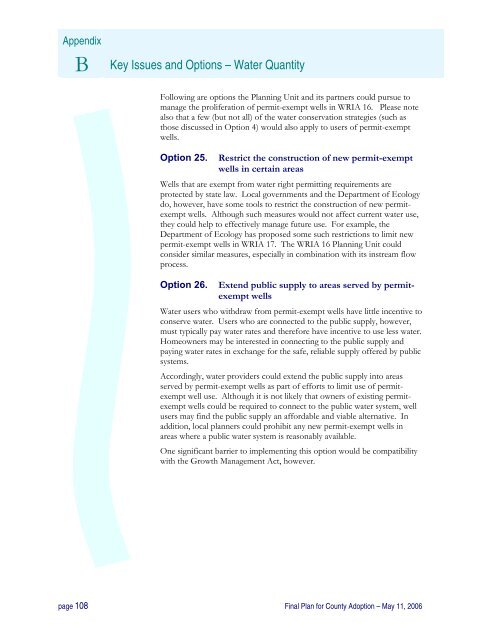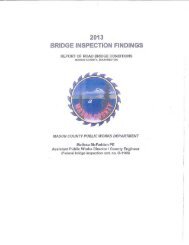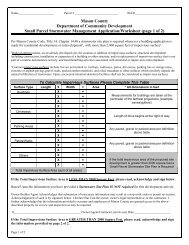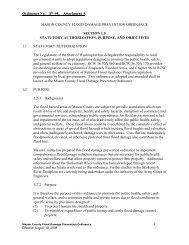Watershed Management Plan - Mason County
Watershed Management Plan - Mason County
Watershed Management Plan - Mason County
Create successful ePaper yourself
Turn your PDF publications into a flip-book with our unique Google optimized e-Paper software.
Appendix<br />
B Key Issues and Options – Water Quantity<br />
Following are options the <strong>Plan</strong>ning Unit and its partners could pursue to<br />
manage the proliferation of permit-exempt wells in WRIA 16. Please note<br />
also that a few (but not all) of the water conservation strategies (such as<br />
those discussed in Option 4) would also apply to users of permit-exempt<br />
wells.<br />
Option 25.<br />
Restrict the construction of new permit-exempt<br />
wells in certain areas<br />
Wells that are exempt from water right permitting requirements are<br />
protected by state law. Local governments and the Department of Ecology<br />
do, however, have some tools to restrict the construction of new permitexempt<br />
wells. Although such measures would not affect current water use,<br />
they could help to effectively manage future use. For example, the<br />
Department of Ecology has proposed some such restrictions to limit new<br />
permit-exempt wells in WRIA 17. The WRIA 16 <strong>Plan</strong>ning Unit could<br />
consider similar measures, especially in combination with its instream flow<br />
process.<br />
Option 26.<br />
Extend public supply to areas served by permitexempt<br />
wells<br />
Water users who withdraw from permit-exempt wells have little incentive to<br />
conserve water. Users who are connected to the public supply, however,<br />
must typically pay water rates and therefore have incentive to use less water.<br />
Homeowners may be interested in connecting to the public supply and<br />
paying water rates in exchange for the safe, reliable supply offered by public<br />
systems.<br />
Accordingly, water providers could extend the public supply into areas<br />
served by permit-exempt wells as part of efforts to limit use of permitexempt<br />
well use. Although it is not likely that owners of existing permitexempt<br />
wells could be required to connect to the public water system, well<br />
users may find the public supply an affordable and viable alternative. In<br />
addition, local planners could prohibit any new permit-exempt wells in<br />
areas where a public water system is reasonably available.<br />
One significant barrier to implementing this option would be compatibility<br />
with the Growth <strong>Management</strong> Act, however.<br />
page 108 Final <strong>Plan</strong> for <strong>County</strong> Adoption – May 11, 2006

















